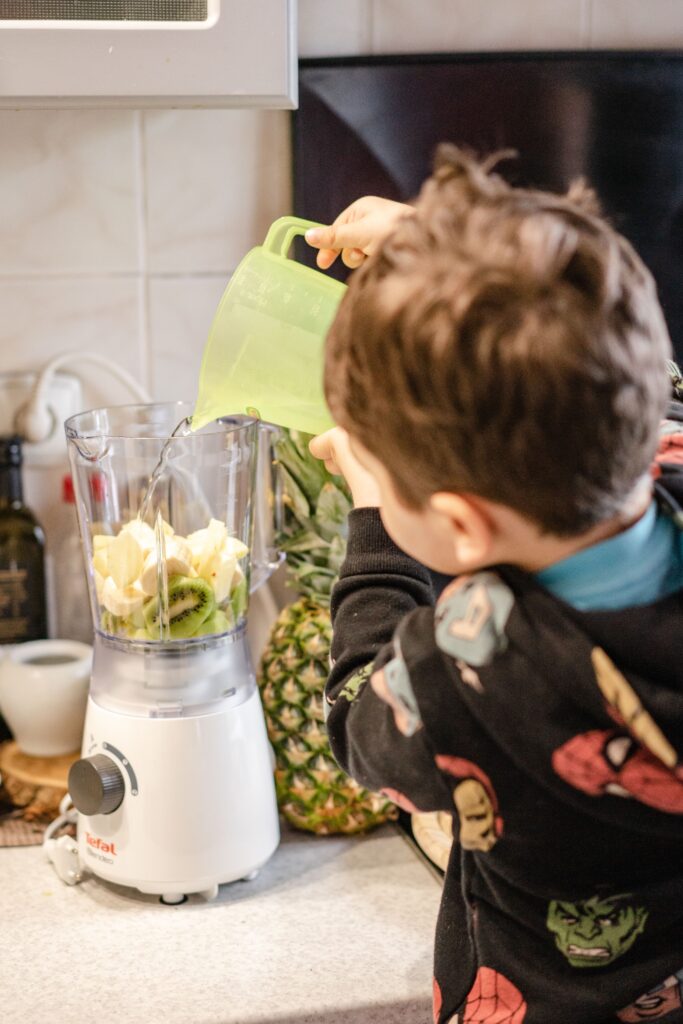Here are some steps you can learn on how to introduce kiwi to your child’s diet. It’s important to do so gradually and carefully.
- Age-Appropriate Introduction: Kiwi can be introduced to your child’s diet after six months of age. Before that, consult with your pediatrician.
- Choose Ripe Kiwis: Select ripe kiwis that are not too firm, making them easier to mash or cut into small, manageable pieces for your child.
- Preparation: Peel the kiwi to remove the fuzzy skin, and then cut it into small, bite-sized pieces. Ensure there are no seeds, as they can be a choking hazard.
- Monitor for Allergies: When offering kiwi to your child for the first time, closely monitor for any allergic reactions. Start with a small amount and observe for itching, swelling, hives, or other signs of allergies. If any reaction occurs, discontinue use and consult a pediatrician.
- Incorporate into Meals: You can add kiwi to your child’s meals gradually. It can be mixed into yogurt, oatmeal, or blended into smoothies. Kiwi can also be a delightful addition to fruit salads.
Kiwi for School-Going Kids

As children grow, their nutritional needs change, and kiwi can continue to play a beneficial role. School-going kids often need a quick energy boost and healthy snacks. Kiwi slices or kiwi-packed lunches can be a nutritious option. You can include kiwi slices in their lunchbox, providing them with essential vitamins and fiber.
Essential Nutrients
Kiwis are packed with essential nutrients that support your child’s growth and development. These nutrients include:
1. Vitamin C
- Immune System Booster: Kiwi is renowned for its exceptionally high vitamin C content. A single serving of kiwi provides more vitamin C than most other fruits, which is essential for a strong and resilient immune system. This means fewer sick days for your child and more time for them to enjoy life.
2. Fiber
- Healthy Digestion: Kiwi is an excellent source of dietary fiber. This fiber aids in promoting regular bowel movements, preventing constipation, and supporting a healthy digestive system. No more tummy troubles for your little one!
3. Potassium
- Proper Growth and Development: Potassium is vital for maintaining healthy blood pressure and proper muscle function. It’s particularly important for active and growing children.
Benefits for Kids
Here are some specific benefits of kiwi for children:
1. Boosting Immunity
- The high vitamin C content in kiwi helps keep your child’s immune system strong, reducing the likelihood of colds and other common illnesses.
2. Supporting Digestive Health
- Kiwi’s fiber content promotes regular bowel movements and helps prevent digestive issues like constipation.
3. Promoting Healthy Growth
- Potassium in kiwi is essential for proper muscle function, which is particularly important for children who are active and growing.
Kiwi for Special Diets
Vegetarian and Vegan Diets:
Kiwis are a wonderful addition to vegetarian and vegan diets. They provide essential nutrients like vitamin C, fiber, and potassium that can sometimes be less abundant in plant-based diets. The natural sweetness of kiwi can also satisfy your sweet tooth without resorting to processed sugars.
Gluten-Free Diets:
Kiwi is naturally gluten-free, making it a safe and delicious choice for individuals with gluten sensitivity. You can enjoy kiwi without worrying about hidden sources of gluten.
Kid-Friendly Ways to Enjoy Kiwi
Here are some creative and tasty ways to incorporate kiwi into your child’s diet:

1. Kiwi Slices
- Simply slice kiwi into rounds or half-moons and serve as a nutritious and visually appealing snack.
2. Fruit Salad
- Mix kiwi with other favorite fruits to create a colorful and refreshing fruit salad that your child will love.
3. Smoothies
- Blend kiwi into a smoothie with yogurt, other fruits, and a touch of honey for a delicious and nutritious beverage.
4. Breakfast Boost
- Add kiwi slices to cereal, oatmeal, or yogurt to make breakfast more exciting and nutritious.
Kiwi as a Natural Remedy
Aside from its culinary uses, kiwi has been explored for its potential health benefits in more therapeutic ways. Some studies suggest that kiwi extract may have anti-inflammatory and sleep-enhancing properties. However, these applications are still being researched, and it’s important to consult a healthcare provider before using kiwi for specific health concerns.
Precautions
While kiwi is highly nutritious, it’s important to consider potential allergies and safety precautions for children:
- Allergies: Some children may be allergic to kiwi. It’s recommended to introduce a small amount and monitor for any signs of allergic reactions such as itching, swelling, or hives. If any adverse reactions occur, discontinue kiwi and seek medical advice.
- Choking Hazard: Kiwi seeds can be a choking hazard for young children. Be sure to remove seeds and cut the fruit into age-appropriate pieces to prevent choking.
Conclusion
Kiwi is a fantastic addition to your child’s diet, offering a burst of essential nutrients that support their growth and well-being. From boosting the immune system to promoting digestive health and overall growth, kiwi is a delightful and nutritious choice.
So, introduce your child to the vibrant world of kiwi and let them enjoy the goodness it brings to their plate.


1 thought on “How to Introduce Kiwi to Your Child’s Diet”